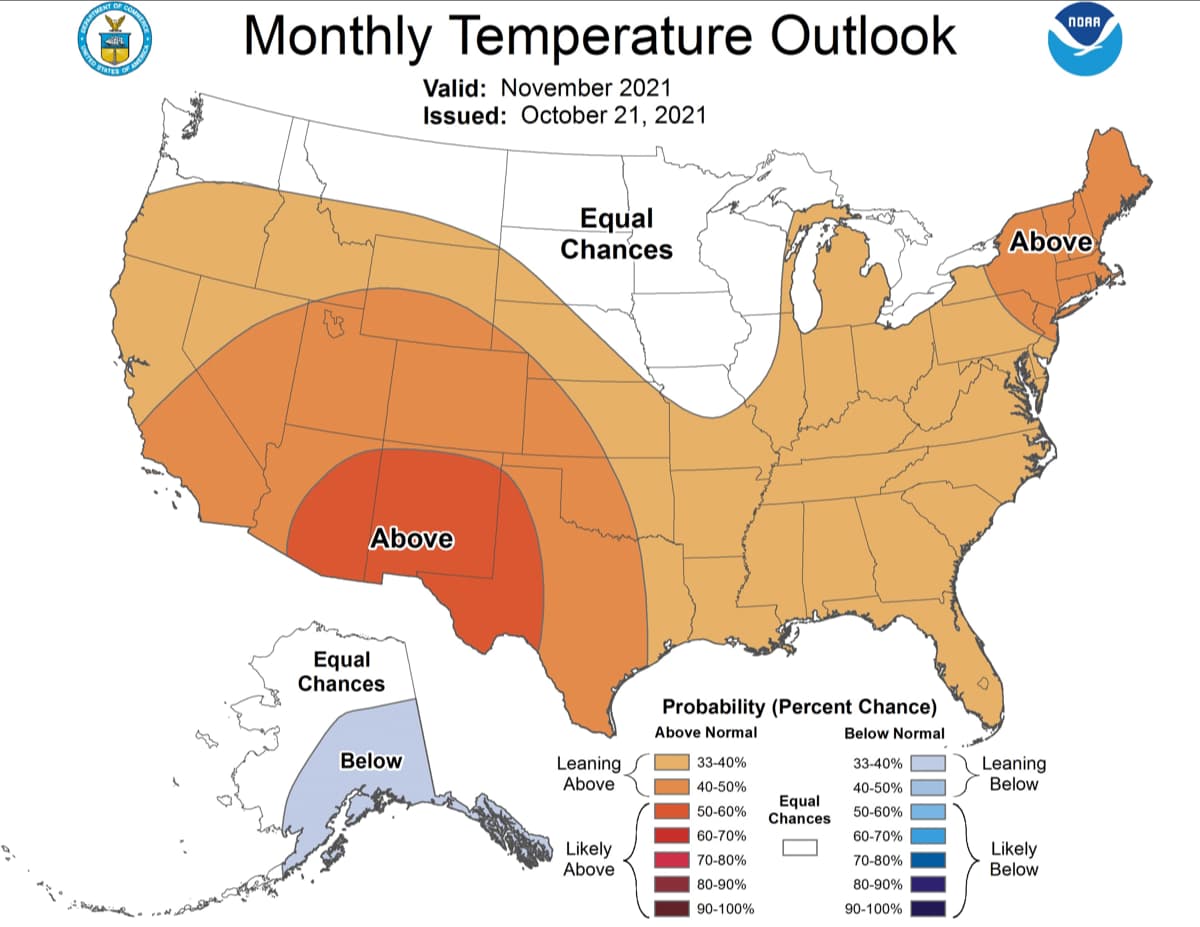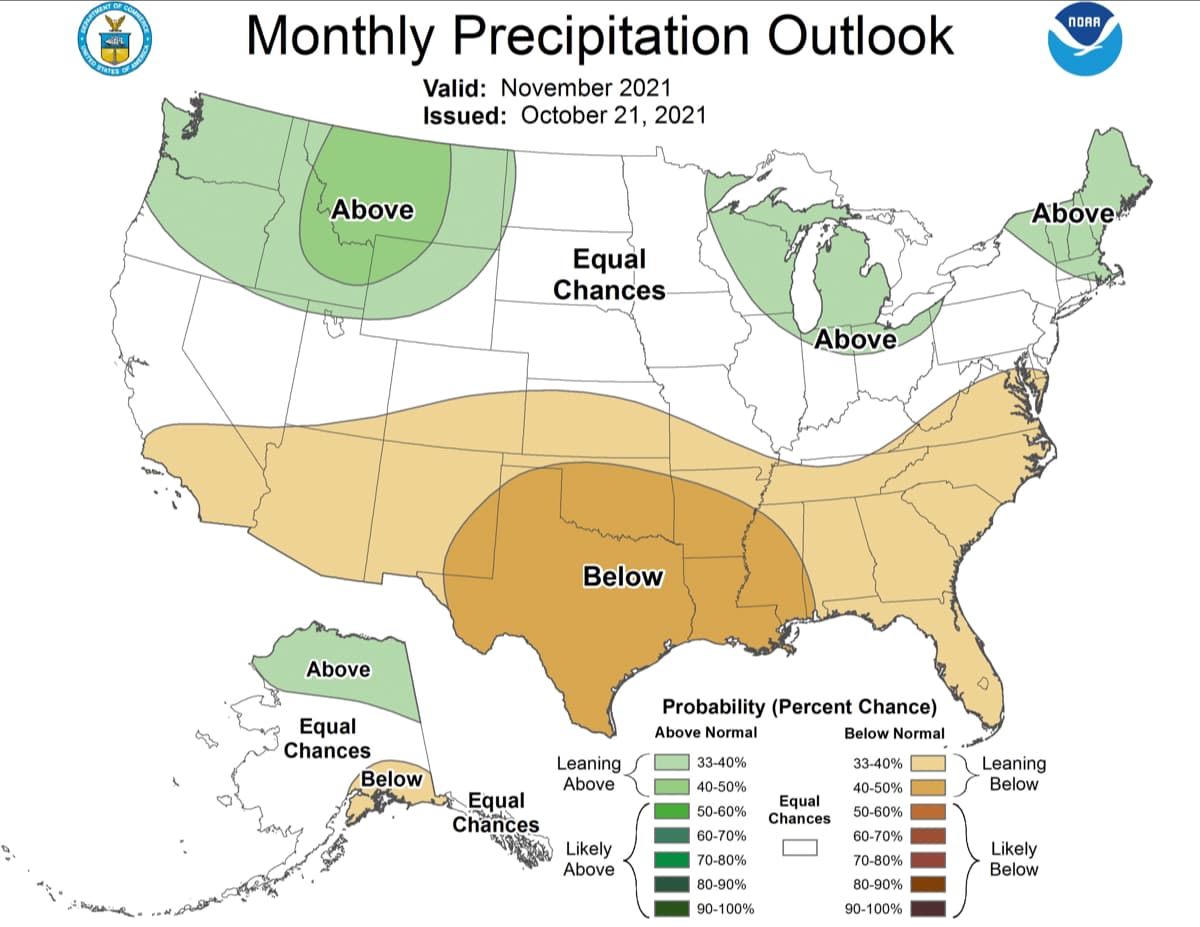
The NOAA has issued its outlook for November. Warmer than average weather is predicted for many areas of the country: the east, south, and most of the west. Drier than normal weather is forecast for the southern half of the nation, with the Great Lakes and Northwest expected to see above average precipitation. A moderate strength La Niña is predicted for the month which is influencing the November forecast.
Full discussion below:
For temperature, elevated probabilities of above-normal monthly mean November temperatures are depicted across much of the contiguous U.S. with the region stretching from the western U.S. eastward to cover much of the central and southern Great Plains, Ohio Valley, and the Eastern Seaboard. The greatest odds are over the southwestern U.S., consistent with expected La Niña conditions and temperature trends, as well as dynamical and statistical model forecast information. The Northeast also has an elevated chance of above-normal temperatures (greater than 40 percent) given large positive local SST anomalies and expected impacts from La Niña.
Conflicting signals in forecast tools support equal chances (EC) of above, near, and below normal temperatures in the Pacific Northwest eastward to much of the Northern Plains and Upper Mississippi Valley. Uncertainty is also high across the Gulf States, as some dynamical model forecasts depict an area of EC. However, a weak tilt toward above-normal temperatures is favored given anomalously warm Gulf of Mexico SSTs.
Observed cold local SST anomalies around Alaska that are forecasted to persist into November support elevated odds for below-normal temperatures for much of southeastern/eastern Alaska westward to the Alaska Peninsula. Additionally, anomalous upper-level ridging off the southern coast of Alaska supports low level cyclonic flow and colder surface air temperatures over southern Alaska. Dynamical and statistical model guidance as well as expected La Niña impacts also support below-normal temperatures over Alaska in November. Though the MJO is forecasted to deteriorate, the potential for suppressed convection over the maritime continent and enhanced convection over the eastern Pacific during week 2 supports cold temperatures over much of interior Alaska.
The November precipitation outlook is influenced by background La Niña impacts, statistical forecast tools, and dynamical model guidance. Elevated odds of below-normal total precipitation amounts are depicted for the southern tier of the U.S., with strongest odds over the south central U.S. Below-normal total precipitation in this region is consistent with expected La Niña impacts and precipitation trends , and supported by dynamical and statistical model guidance. Expected La Niña impact to the gulf states and Florida is typically enhanced odds for below-normal precipitation, but disagreement in dynamical and statistical models warranted a shift of the strongest probability to the south-central U.S.
Dynamical model guidance and La Niña impacts support elevated odds of above-normal precipitation for the Pacific Northwest stretching into Montana and parts of Wyoming. Though there is evidence of elevated odds for above-normal precipitation across the entire region, the strongest probabilities are shifted eastward due to high precipitation climatology in the more western parts of the region. A second region of mildly elevated odds of above-normal precipitation stretches from the Great Lakes into the northern parts of New England, supported by expected La Niña impacts, statistical, and most dynamical model guidance. Given the potential for lake effect precipitation as we enter into the colder parts of the year, slightly elevated odds for above-normal precipitation are depicted over the Great Lakes.
Weak probabilities of below-normal precipitation are forecasted for southeastern Alaska, shifting to weak probabilities of above-normal precipitation in northern Alaska, consistent with statistical model guidance. La Niña and long term precipitation trends support this pattern, as well as potential for more open water north of Alaska in early winter.
